Online discussions regarding what makes the best combat handgun sights will too often devolve to arguments over sighted vs. unsighted fire. The armchair warriors and keyboard commandoes often come out in strong support of their various, yet inexperienced, views.
Unfortunately, the clamor of fools often drowns out the voices of reason and experience.
I’ve actually had people tell me that “The glow from a night sight got my buddy killed when fighting in the Rhodesian Bush War” and “The first thing I do with any new handgun is file off the sights ’cause no one ever uses their sights in combat.”
The things I’ve read online stray even farther into the land of Captain Silly and his Fantastical Elves.
Let’s take a look at some of the realities of sights in combat and what might constitute the best handgun sights.
Using Sights in Combat
Let me start by saying, I don’t claim to be an expert – just a student. If I can share anything that helps you make an informed decision, great.
As a guy who carried guns during more than ten years of law enforcement service, I’ve been in my fair share of armed, violent encounters. Each one was different from the others, but I developed a few preferences in handgun sights based on my experiences and training.
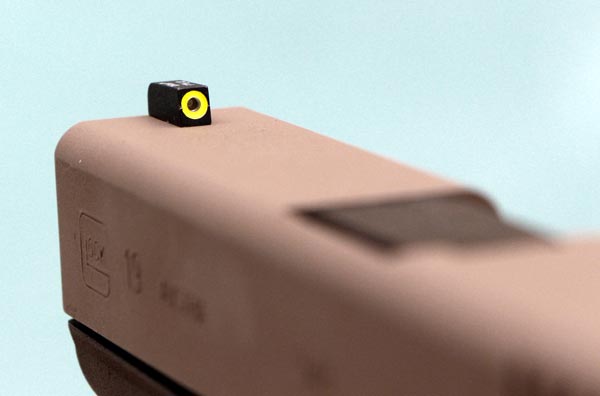
Additionally, I’ve read a lot of work that has been done on officer-involved shootings, body alarm response, sports performance under stress, and the effects of critical incident stress on vision and perception. I’m going to skip a lot of the physiology in this article. However, there is a lot of interesting information out there on the general subject, and I will have a list of a few resources at the bottom of the article.
Frankly, I do not think anyone has figured out the perfect way to train for accuracy in combat, nor do I think anyone has the ideal sighting solution for sale. I merely believe that some systems – both training and products – tend to work better than others.
I think there are times to use your sights and times you cannot use your sights. Generally, I believe that if you are at all able to, using sights is better than not using sights. However, there are times that a training discipline might say sights are not needed, while I would suggest they are. I guess I always fall back to the maxim of “You can’t miss fast enough to win a gunfight.”
Sight use doesn’t always mean a perfect sight picture with a crisp front sight perfectly aligned with a rear sight. For longer distances and precision shots, this is still the best way to put holes in the target. But for closer distances, getting just the front sight on the target will often get the job done.
Generally, I have found that handgun sights are more likely to be used than not when these three things happen:
- the shooter regularly trains to use the sights,
- the shooter is not completely surprised by the attack, and
- the sights are easy to see and are not visually confusing.
The first item, regular training, should be obvious. If you train to do something, you are more likely to do it under stress. The more frequent and realistic the training, the more likely the shooter will use the sights. Keep in mind that this is not a guarantee; it just improves the likelihood.
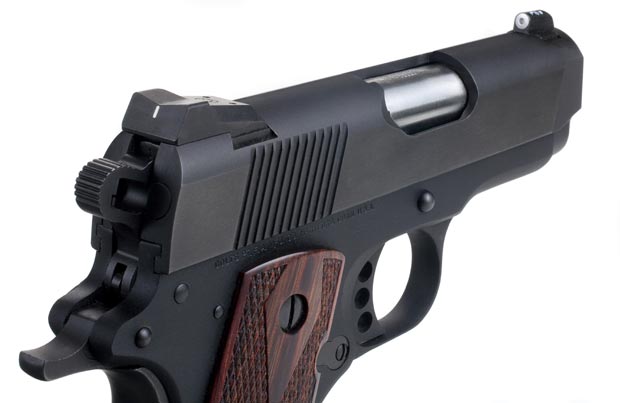
Surprise, the second item, can completely override all but the most intense training, causing the attacked person to have a primal response that is not necessarily the best for achieving accurate fire on a target. But, the more aware the person is of pending danger, the less likely he or she will be surprised to the extent they will abandon all training.
Consider this to be a sliding scale or a measure of degrees, and not an on/off switch. A person walking through a haunted house at a carnival is not likely to have as strong a primal response as the same person when someone jumps out at them while walking through their own house at night. In both cases, surprise plays a role, but in the first instance, the person is expecting something to happen, and will not have as pronounced a reaction. He or she will have an increased ability to control his or her physical response.
Applying this concept to shooting, consider a police officer searching a building for an armed felon. He or she might be surprised when the armed felon steps out into a hallway in front of them. But, since the officer is mentally prepared for possible combat when the confrontation occurs, the officer is likely to use his or her sights if they have trained to do so.
Compare the same officer who pulls into the parking lot of an ice cream parlor to get a cone. As the officer is walking up to the door, he or she is thinking about taking the kids camping soon and isn’t aware of what is going on around him or her. When a man bursts out of the store shooting at the officer, the officer is completely surprised – going from a state of walking unconsciousness to responding to a lethal threat. This officer is more likely to initially respond in a primal way and is less likely to use sights than in the prior incident.
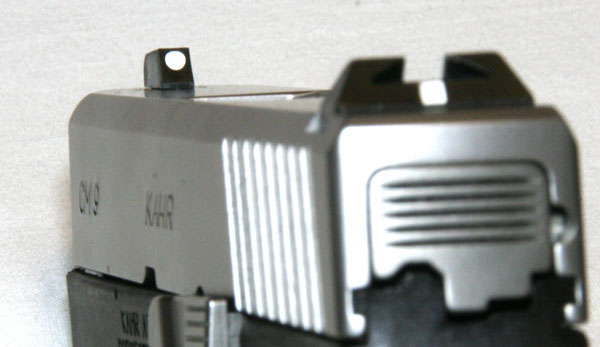
If an incident lasts more than a few seconds, the body can adjust to combat and an even surprised officer can regain some conscious control over his or her actions. Several officers have told me that after the initial few shots, they slowed down, concentrated on the front sight and got hits.
The “Perfect” Sights
There are no perfect handgun sights or at least none I’ve ever found. However, some tend to work better than others.
My view is that if a front sight is large and of a bright, contrasting color, it is more likely to be used than not. The larger or the brighter the color, the more likely the shooter will be able to use it in combat.
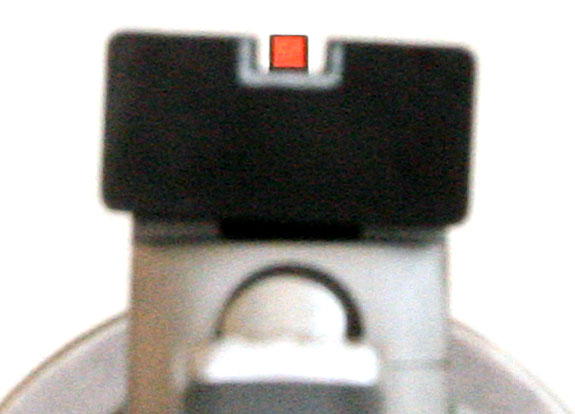
I’ve experimented with different kinds of sights, and I am still searching for the best one. Right now, I have an AmeriGlo ProGlo front sight on my Glock 19. This site has a tritium vial in the center with a fairly large green ring around it. The ring is photoluminescent, meaning it glows brightly after being exposed to light.
I’ve improved the visibility of the front ramp on my Smith & Wesson 642 (a small revolver) with bright, neon-orange fingernail polish. The orange is much easier to see in all kinds of lighting than the matte stainless finish. If you are thinking about doing something similar, I encourage you to lay down a base layer of white first.
I personally like a tritium vial (the radioactive material that causes a night sight to glow), but few are very bright and none are large enough to act as a good sight alone. So, having a bright outline around the tritium vial is a must. That’s one of the reasons why I am currently using the AmeriGlo sight mentioned above.
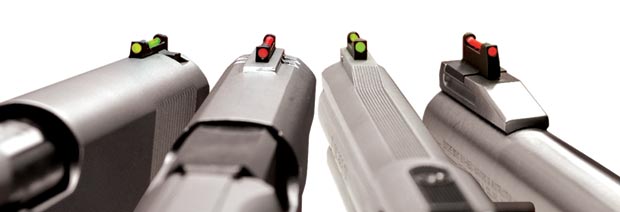
A fiber optic sight is very good for gathering available light and producing an easy-to-see sight. However, some fiber optic sights are not well protected and are prone to damage in the realities of combat. Damaging a fiber-optic sight may be harder than most people suggest, but the decision to use one is up to you.
Rear Sights
For my tastes, the rear sight should have a wide, but crisp notch. This allows for a faster alignment when you are closer to the target, but the defined notch still allows you to make a precision shot when needed. I’ve never cared for the three-dot sights, but have never had an issue with the “box” or outline that is used by Glock on the company’s normal sight.
I do not like tritium vials on the rear sight. In low light conditions, having three dots floating around in the darkness can cause visual confusion. It may take only an extra moment for the brain to understand what it is seeing (with the three glowing dots), but that is a moment I cannot afford to waste when my life is in danger.
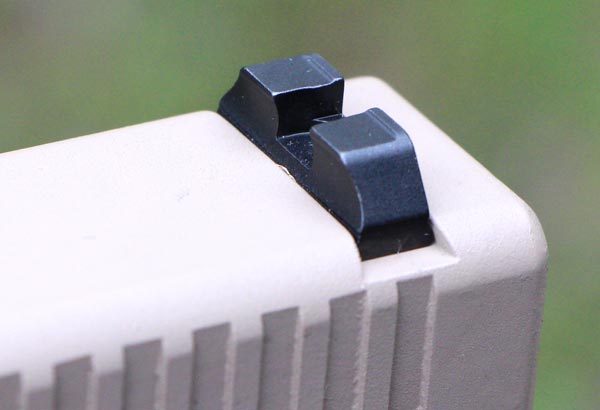
One thing that I feel is an absolute must is the rear sight has to have a flat front, a hard edge, to use for running the gun one-handed. There are many documented incidents where a good guy has been wounded in one arm or the other, requiring him or her to run a gun one-handed. This means reloads and malfunctions have to be handled without a support hand.
When a pistol has one of the Novak style, ramped front sights, the one-handed shooter has to try to manipulate the slide from the ejection port. This is a difficult proposition and cover garments can become entangled in the port.
A much better solution is to rack the slide from the rear sight. With a flat front sight, this is a very easy procedure. With a ramped sight, it is not likely to happen, and you will be forced to try to use the ejection port.
On my Glock 19, I am using an I.C.E. Claw rear sight. It is a plain black sight (no dots, lines or boxes) with a wide notch. The front of the sight has a slight “hook” or claw that makes it extremely easy for a shooter to run the gun one-handed.
Electronic Sights
The success of electronic, or red dot, sights on rifles is undeniable. During the past dozen years, electronic sights have proved to be extremely durable in very rugged environments. It is only natural that their use would migrate to combat handguns.
There are a variety of options for mounting electronic sights on your defensive handgun, but the Trijicon RMR (Ruggedized Miniature Reflex) sight seems to be the current market leader. I’ve had a small amount of time with this sight and found it to be fast and accurate.
Testing that others have done shows that this is a very durable sight. The RMR is tough enough that it can be used to work the slide if you are running the gun one-handed.
Electronic sights are not a cheap option. The RMR will set you back around $500, plus you need a way to mount the sight to the gun. For most people that means a smith will have to machine the proper size cut into the top of the slide for optics mounting. A few companies (such as Smith & Wesson) offer pistols with the cuts from the factory.
Final Thoughts
I hope that some of the information here will be of benefit to you. I don’t expect anyone to agree with me, but I do hope that you take the time to comment below. If you’ve got a different view, please share it with the rest of us in the comments section below.
Resources
- Body Alarm & Reaction – Sports Vision by Edward C. Godnig, O.D.
- Glock 42 Night Sights List
- Glock 43 Sights
- Guns, Bullets and Gunfights by Jim Cirillo
- Handgun Combatives by Dave Spaulding
- HK VP9 Sight List
- Sharpening the Warrior’s Edge: The Psychology and Science of Training by Bruce K. Siddle
- Springfield XD-S Night Sights
- StressFire by Massad Ayoob
- Trijicon RMR handgun sight
- Vision and Shooting by Edward C. Godnig, O.D.
- What Really Happens in a Gunfight? By Dave Spaulding
Disclosure
GunsHolstersAndGear.com is a for-profit website. I do not charge readers a dime to access the information I provide.
Some of the links on this page and site are affiliate links to companies like Amazon and Palmetto State Armory. These links take you to the products mentioned in the article. Should you decide to purchase something from one of those companies, I make a small commission.
The links do not change your purchase price. I do not get to see what any individual purchases.
Last update: June 5, 2021
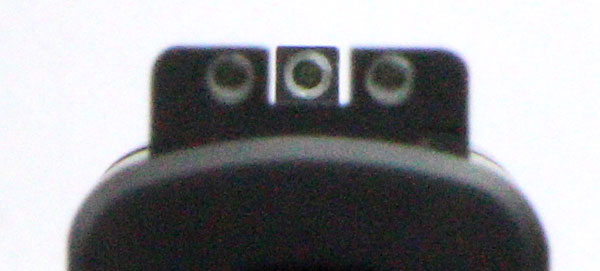
10 replies on “The Best Combat Handgun Sights”
A very good review and discussion on pistol sights. I agree that the front sight is critical. It should be large enough to quickly acquire, but not so large to obscure target areas at medium distances out to 25 yards with some form of self-illumination for night shooting
Traditional 3-dot systems can be difficult to line up during day, and very hard at night. If the space between the rear sight risers is big enough that helps, but a single illuminated dot up front with enough space to quickly acquire the front sight is likely the easiest way to shoot quickly and accurately.
There is a reason red-dot sights are so popular with rifles – they are fast to acquire and shoot accurately. I think the same can be said for pistols.
I’m not sure why you are any different than the many “keyboard commandos” who have written much the same thing. One “keyboard commando” is much like another. However, this is a very good article from one of the better “commandos”.
As mentioned in the start of the article, Richard spent over 10 years working the beat as a police officer, supervisor, and trainer, before devoting his career to internet gun forums. His real-life firearm experience supports a more professional opinion.
Many commandos talk about what worked and didn’t work at the range, or carrying concealed, etc. Richard speaks from the perspective of someone who has pointed a firearm at another human being, and probably had the same done to him.
In that perspective, “what works and doesn’t” takes on a whole new level of importance.
Very good article. I definitely see things going to the red dot sights. They are sort of like lasers, but with fewer drawbacks. You can better focus on the target.
I really like the look of that AmeriGlo sight. And the price is pretty good on that.
I agree about the bright front sight since I am a little older I am able to find it quicker.I have recently tried the the lollipop type sighting putting the ball on the stick. I have to say this is another addition that has seemed to help me become a little better,both with quickness of sighting and accuracy HS sights have worked for me. If you have accuracy issues first examine your technique then try these HS sights
XS sights NOT HS sights sorry for the mistake
Thanks for this article. I’m getting ready to buy my first gun — Springfield xdm 3.8 9mm — and want to put some night sights on it. A local shop told me they should install it because of the equipment they have and the requirement of so many pounds of force needed for the installation yada yada. I found a youtube video and was going to do it myself. Any thoughts? Also, has anyone tried Meprolight TRU DOT Night Sights?
Thanks, your article is a great bit of good advice. Like many aging people,my eye muscles do not focus rapidly. The bright big front sight is the best way for me to be on target. Thanks again.
I went to the local range wear I was told a guy could move my rear sight over for free, which he did. He then said I needed some better sights. My response was blunt but I feel true. In a gun fight I will just point and shoot. The sights would then be used after I had shot six rounds at the bad guys center mass. This is what I practiced, with a holstered weapon draw and fire six rounds at center mass as fast a possible without shooting my foot from the three yard line. Weapon of choice 1911.